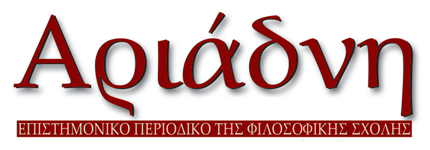Αρχιτεκτονικές αποκαταστάσεις προϊστορικών τάφων από τον Μόχλο και τα Γουρνιά στην Κρήτη: «οργανική αρχιτεκτονική» και κοινωνικά συμφραζόμενα
DOI:
https://doi.org/10.26248/ariadne.v12i0.958Περίληψη
The prehistoric cemeteries of Mochlos and Gournia have been considered to be examples of "organic architecture". The term describes buildings that take advantage of natural bedrock ledges. As a result, built parts resemble organic extensions of the natural setting. 'Όrganic architecture" demonstrates the dialectic relationship between architecture, topography and socio-historical process. Such significance hinges upon the ways in which the tombs of Mochlos and Gournia may be reconstructed. For this reason, this paper presents a study of tomb ΠΙ at Gournia and tombs Ι/ΙΙ/ΙΙΙ and IV /V /VI at Mochlos. They were all built in the Early Minoan ΙΙ period and constitute some of the most monumental examples of funerary architecture of the period. As a result, they occupy a central place in all arguments οn the understanding of Early Minoan social processes. Their study has been based οn the extensive literature as well as new field measurements. Α series of photorealistic models presents alternative reconstructions of the tombs. By comparing different pictures, viewers are able to retain their critical spirit and appreciate better the arguments that this paper offers οn the social importance of "organic architecture". The latter is understood as part of a social discourse that distinguished between locals and visitors, because the monumentality of the tombs was better apprehended by the former rather than the latter. Locals had the necessary knowledge to zoom into the detail of the landscape they inhabited and used οn a daily basis and thus distinguish between natural and manmade features. The visitors' view had to be restricted to a coarser grain resolution. The appreciation and understanding of "Organic architecture" required a certain degree of practical knowledge, which thus served the reinforcement of local identity. This reinforcement was further accentuated by the funerary character of these buildings. As repositories of the material remains of past generations, the tombs were places of collective memories and, hence, treasuries of local tradition and history through ritual activity that emphasised kinship, lineage and ancestry. Ιn this respect, "organic architecture" was much more than simply a practical technique for economising time and material in building. It was a practice, which occupied a firm place within social discourse.
Λήψεις
Δημοσίευση
Πώς να δημιουργήσετε Αναφορές
Τεύχος
Ενότητα
Άδεια
Οι εργασίες που δημοσιεύονται στο περιοδικό μπορούν να χρησιμοποιηθούν ελεύθερα για μη-εμπορικούς σκοπούς με την προϋπόθεση ότι γίνεται αναφορά στους συγγραφείς και την πρώτη δημοσίευση. Στην περίπτωση που το άρθρο αλλοιωθεί, τροποποιηθεί ή δημιουργηθεί κάτι νέο βασισμένο στο αρχικό, το έργο που θα προκύψει θα μπορεί να διανεμηθεί μόνο με την ίδια ή παρόμοια άδεια (Creative Commons Attribution-NonCommercial-ShareAlike 4.0 International License).


